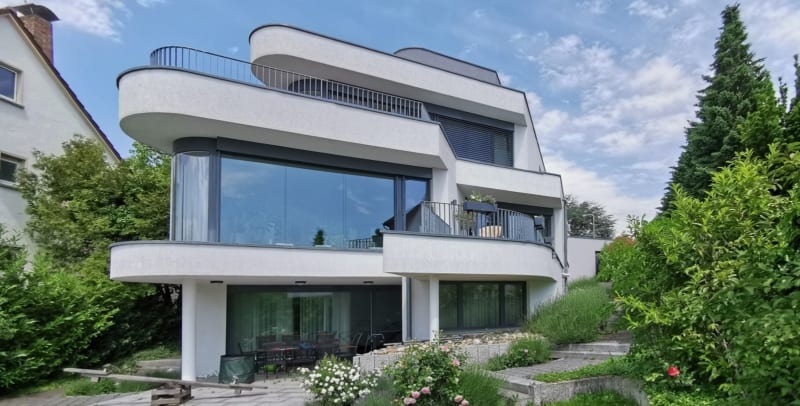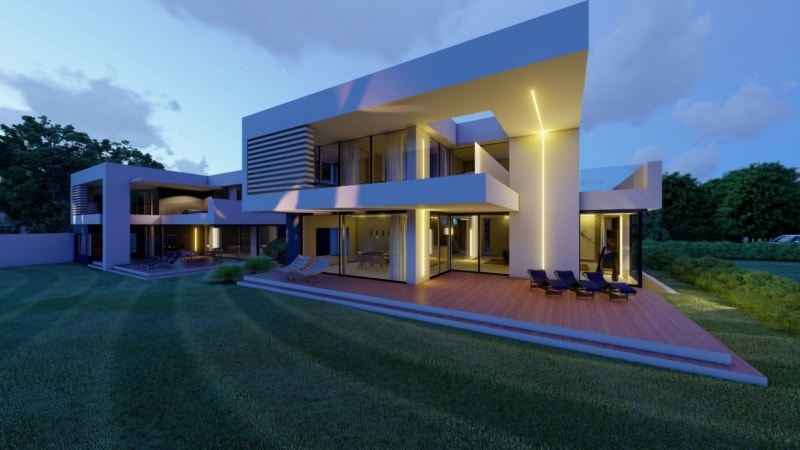Building houses in the Bauhaus style
Do you want to build a modern Bauhaus-style house?

Many of our customers ask us for a design for a “Bauhaus style house”. Our answer is always the same: there is no such style, but we know what you mean. The term has become established for prefabricated houses. You want a house with a flat roof, often with white plaster and a cubic, clear and modern design. The design should be as timeless as possible, with extensive window areas facing the garden and without overly unusual elements such as sloping supports. Then we show the following three references and get the answer: yes, this is the direction we want to go in.
Architect’s house in Bauhaus style in Bad Soden
“Even today – two years after moving in – we are still delighted with the very successful, calm and yet elegant architecture of our house.”
Prof. Dr. Daecke
Flat-roofed houses experienced their big boom at the Bauhaus. This design for an architect’s house plays with the expressive ceiling panels and contrasts them with vertical wall panels. The linear architecture is timeless yet exciting and is not limited to a mere cube.

Bauhaus style house in Berlin-Zehlendorf
“We wanted a strong, symbolic and yet restrained façade facing Clayallee (one of Berlin’s major avenues), preferably simply a large cube – you have captured this exactly and we like it very much”.
Mr. Mundt at the handover of the final draft.
A floating structure with a frame facing the street, large windows with a 2-storey high entrance door and 7m high wooden slats. The garden side has the largest window front we have realized so far: it is 17m long x 4m high. Of these, 50% can be opened and an almost frameless glazing (skyframe) opens the house 100% towards the garden.
Bauhaus style houses
What requirements must modern Bauhaus-style houses meet? What technical challenges need to be considered when building a house with a flat roof? You can rely on our experience of more than 2 decades in the realization of such “building houses”. The floor plan is individually tailored to the future residents. An individuality that a prefabricated house can never offer. The house meets the latest requirements for energy efficiency, equipment and smart home control. Generous window areas bring light into the home.
Our architectural approach is sculptural and goes far beyond a simple cube house. For us, every project is a complete work of art.
Your advantages at a glance
- Exclusivity through your personal unique design
- Security through meticulous implementation during house construction
- Creativity through innovative interior design concepts
- Individuality through masterfully staged architecture, precisely tailored to your pre-selection
- Planning reliability through interdisciplinary planning without interface losses
- Efficiency through virtual pre-sampling of the building
- Budget security through general contractor-trained calculation and tendering
- Quality thanks to our experience from over 90 completed projects (> References)
- Presentation as a model with removable covers as a 3D print, as a working model or as a precision model
- Innovative solutions for private builders & medium-sized companies
- Turnkey realization with our construction partners
Brüderhäuser: 2 Bauhaus villas next to each other
On the occasion of the very first approx. 5-hour meeting in our 3D studio:
“You took a lot of time and answered all our many questions exhaustively. It was all very informative. We now feel quite confident that you will meet our specifications and look forward to seeing your designs for the two houses. You can really tell that you are enthusiastic about what you do and love your work!
… We also like some of the many special materials you have presented here and we hope to receive further expert advice from you!”
And on the occasion of the handover of the advanced design:
“We can now say that the direction is right and we are very happy with the designs. Great work! Thank you and your team.”
Families N. and S. Kappel before the Bruderhäuser design plans were approved for planning application.
The Bauhaus style
Many of our customers use this term to give us a concise picture of their wishes. Clear cubic shapes, right angles – sometimes rounded, white façades and, last but not least, the flat roof are the attributes that usually come to mind first and that they have often already seen in our projects. Now they want to entrust us with the task of designing and building their new home in this “Bauhaus style”.
Is there actually a Bauhaus style?
In the following, we will look for answers in the history of BAUHAUS and give you an idea of the life and work of creative people.
For all of us, BAUHAUS and the achievements that emerged from this institution and its surroundings in the last century represent one of the beginnings, a start to modernity that has rarely been seen in such a condensed form. Such a concentration of profoundly creative (free) spirits of all artistic genres at one institution had never been seen before the founding of the Bauhaus in 1919. Today it is often rightly described as the most important art school of the 20th century.
“Nowhere else has there been such a concentration of (free) spirits from all artistic genres.”
Numerous articles offer many often unknown aspects. We are surprised by many little things that make the special human situation that led to these epoch-making innovations ever clearer. Be it snapshots from the completely private sphere of the Bauhaus members or the results of the students’ exercises – everything has its very own aura. It is fascinating to observe the students in many curious, thought-provoking and everyday situations and to make comparisons with today.
The Bauhaus style today
A number of barriers have fallen over the last few decades: new materials have been developed, 3D visualizations and graphic designs in the Bauhaus style can be created in an acceptable form by any reasonably talented person with computer support, and you would think that everything you are currently working on has already been designed or realized. Every creative person is familiar with those unpleasant déjà vu moments when you think you have developed something for the first time and then discover an undoubted counterpart that takes this assumption ad absurdum.
At the time of the Bauhaus, things were different: after centuries of classical representational and ornamental art, the first abstract and truly new art objects came to the attention of what was then still a very small community of enthusiasts. In the early days of hand drawings and reinforced concrete construction, not everything was thought of, not everything that was obvious was realized. A three-dimensional drawing of a Bauhaus artist without any visible derailment of the pencil or a very simply designed invitation card to a Bauhaus festival with hand-drawn lettering in a pure and clean form – even if today one can sometimes recognize them as outdated in their idea and execution – are testimonies to an unadulterated creative work that can really be read for the first time in these special results.
After a catastrophic war and a lot of political turmoil, people came together in a very special atmosphere of free individuality and collective creativity, recognizing themselves as like-minded people and developing innovations together and across genres, some of which are still unparalleled today. Of course, this was primarily due to the special teachers at the Bauhaus Academy, who were prepared to break completely new ground. It is remarkable that so many absolute individualists with their avant-garde ideas came together here as a collective.
An important indication that something completely new had been created here is, for example, the fact that the statutes of the BAUHAUS already stated that “any blameless person, regardless of their gender or previous education” was allowed to study here at any time. At a time when women were generally not allowed to study at academies, this was a clear sign.
A friendly relationship between the teachers and their students was a declared goal and completely unthinkable for traditional structures at German universities. Joint theater performances, many festivals, lantern parades, masked balls and excursions led to diverse relationships between the participants – 71 marriages were the result.
“Fun fact: 71 marriages took place within the Bauhaus school.”
The new teaching methods in combination with the living, spatial and learning structures, which could only be described as avant-garde at the time, naturally also generated new results. The interpersonal relationships between masters and students formed a very special breeding ground. On her second evening at the Bauhaus, one student wrote that she felt like she was in a frenzy:
“A large hall with white-covered tables, green walls, music, cheerful games, the people who have all come here to get serious are still complete strangers, but they want to get to know each other, is there a better idea than cheerful, purposeless get-togethers, dancing and playing? We were thrilled with this beginning.”
The Bauhäusler saw themselves as pioneers of the modernization of society and behaved as such. “The boys’ hair was long, the girls’ skirts were short. They went without collars and stockings, which was shocking at the time. They designed a Bauhaus garment, invented the Bauhaus whistle, the Bauhaus salute…”, in short, they felt they were something special. Just imagine how Johannes Itten must have looked to his new students (and even more so to the female students!) in his – even by today’s standards – completely outlandish outfit and how he must have been a truly dazzling figure in the remarkably strong colors of his robes. Barbara Hein writes in her very successful article about BAUHAUS in ART 7/2009:
“The undogmatic life at the Bauhaus repeatedly caused outrage among the citizens.”
But we have not yet made any progress in specifying the “Bauhaus style ” – and the attempt makes no sense. There is no such thing as the “Bauhaus style”.
There is only the truly stylish idea of trying to create something truly new from nothing with the help of your own mind – and also with the inspiration of past generations. Every good architect tries to do this, knowing full well that a BAUHAUS cannot be repeated. Why should it, the train of knowledge has already arrived several stops later – and it keeps on going – every day. In this sense, a single-family house in the Bauhaus style is a good way for our customers to communicate their wishes concisely – for us as architects and designers, the Bauhaus style also expresses an entire lifestyle.
Conclusion: There is no such thing as THE “Bauhaus style”.
Author: Hans Heinze
Sources:




